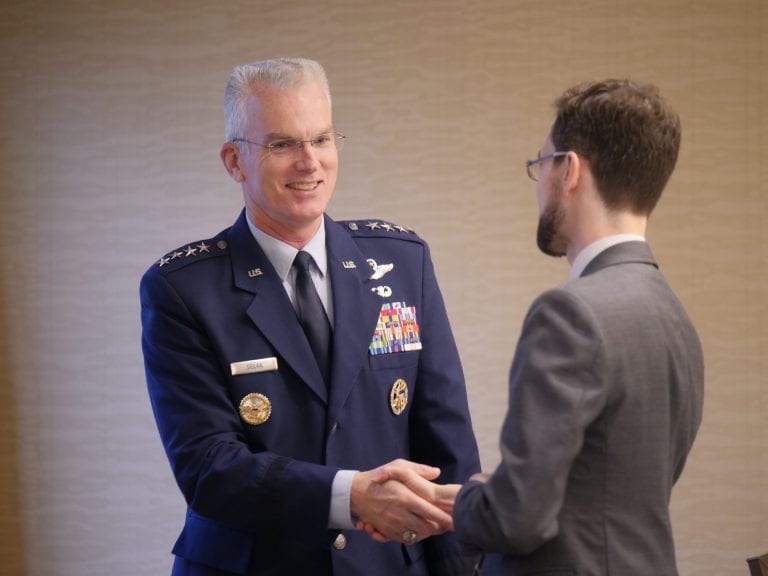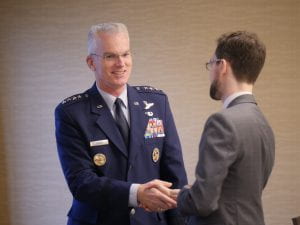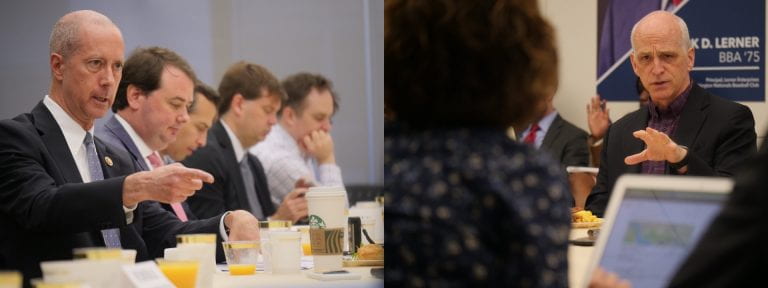Deasy Faces Senate Confirmation as IT Portfolio Progresses by Rachel Cohen of Air Force Magazine
Pentagon Chief Information Officer Dana Deasy will come under congressional scrutiny to stay in the same role, thanks to legislative language in the 2018 National Defense Authorization Act that turned his job into a presidentially chosen, Senate-confirmed post at the start of 2019.
President Donald Trump formally nominated Deasy on June 25. The CIO found out the announcement was posted during a Defense Writers Group breakfast that morning, but said there isn’t anything notable about the timing. The legislative change reflects Congress’s recognition of technology’s growing importance to the military, he argued.
Heading into his Senate confirmation process, Deasy wants members to think about the issues that fall under his portfolio—information management, technology, and assurance; certain space systems; satellite and telecommunications; navigation and timing programs; electromagnetic spectrum; and artificial intelligence—as interdependent parts of a bigger whole.
“When I arrived and I started conversations with different members, it was a variety of topics … it was cloud, it was [artificial intelligence], it was various parts of [command, control, and communications], it was about people, it was about organizational structures, data management,” Deasy said. “It just screamed out to me that this was connected, but someone just needed to step back, look at the individual pieces, be able to explain what each piece is trying to accomplish … and then bring it together into kind of a holistic story.”
Data—as well as the general-purpose, global cloud system envisioned to hold it, the algorithms used to crunch it, and the means of keeping it all safe—will sit at the core of military operations going forward. Deasy provided updates on three key pushes expected to change future warfare: the enterprise cloud effort known as JEDI, a rollout of 5G networks at bases across the country, and pilot programs at the Joint Artificial Intelligence Center.
The Pentagon anticipates issuing a $10 billion contract to Amazon or Microsoft for the Joint Enterprise Department Infrastructure (JEDI) cloud in late August, even as Oracle awaits the outcome of its challenge to the program in federal claims court. Deasy said the ruling will not affect the contract award. Oracle and IBM’s bids were rejected earlier this year. Oracle alleges the Defense Department wrote its program requirements too narrowly and that Amazon offered two DOD employees jobs while they were working on JEDI.
“JEDI Cloud will enable the warfighter to quickly convert data to actionable information, which is recognized as critical by all of the combatant commands,” according to Joint Staff CIO Lt. Gen. B.J. Shwedo’s June 7 testimony in Oracle America v. US and Amazon Web Services. “Having an enterprise-wide cloud environment allows the data to be aggregated. Once aggregated, advanced analysis capabilities like [AI] and machine learning can be used to ensure the warfighters are receiving analyzed data in a reduced amount of time.”
The cloud should also be accessible when networks are cut off and is expected to boost military training and equipment maintenance.
Deasy noted that in the last six months, his office has reached out to commanders around the world who have a “significant amount of pent-up demand” for cloud capability. DOD will pull together a list of programs that are the top candidates for early migration to JEDI.
In addition, he said the department is assembling a list of military bases that will be the first to test out 5G network infrastructure and help refine the Pentagon’s approach to future wireless capabilities. He added that a predictive maintenance pilot at the JAIC recently offered its first algorithm to US Special Operations Command and the Army to help battle the negative effects of sand in Black Hawk helicopter engines.
Original article can be found here.
Other articles:
National Defense Magazine: JUST IN: Despite Legal Challenge, JEDI Cloud Computing Contract Award Expected in August (UPDATED)
MeriTalk: JEDI Contract Announcement Seen in August, Deasy Says
Federal Computer Week: JEDI award expected in August
Washington Technology: DOD says JEDI award happens this summer
Inside Defense: Top DOD official cites need for 'dynamic spectrum sharing,' as military prepares 5G 'use cases'
Pentagon eyes end of August for JEDI cloud award
Federal News Network: JEDI award delayed, DoD CIO preparing agencies for its arrival
Fifth Domain: Pentagon’s top IT official formally nominated for his own job
Defense Daily: Pentagon To Now Award $10 Billion JEDI Cloud Contract In Late August, DoD CIO Says
Bloomberg: DOD Tech Chief Prepares for `JEDI' Cloud Amid Court Battle
Defense One: Pentagon Aims to Award JEDI Cloud Contract in August









